Best 27 Inch 1440p Gaming Monitor
Navigating the world of gaming monitors can feel like wandering through a labyrinth of specifications, marketing buzzwords, and dazzling price tags. If you’re ready to level up from a basic 1080p screen but aren’t quite ready to invest in the lofty sums often demanded by 4K displays, you’ve arrived at the sweet spot: 1440p. Also known as QHD (Quad High Definition), 1440p delivers a resolution of 2560×1440 pixels—offering a noticeable leap in clarity, detail, and immersion over Full HD while remaining far more affordable and easier to drive than its 4K counterparts.
Why 27″ and Why 1440p?
Screen Real Estate: The larger 27-inch size provides more workspace for multitasking or in-game HUD elements, while the 16:9 aspect ratio maintains broad compatibility with games and media.
Optimal Pixel Density: At typical desktop viewing distances (24–32 inches), a 27-inch 1440p panel delivers around 108 pixels per inch (PPI), balancing sharpness and readability without the scaling concerns of higher resolutions.
Performance-Friendly: Compared to 4K UHD, 1440p demands roughly 2.3× fewer pixels, making it easier for GPUs to drive high refresh rates in modern titles.
A Spectrum of Budgets
One of the greatest strengths of the 1440p market is its breadth. Whether you’re pinching pennies or wielding a more generous budget, there’s a QHD gaming monitor tailored to your needs:
- Entry-Level (approximately $120–$180): Often measuring 24–27 inches in size, these monitors typically feature a 60–75 Hz refresh rate and an IPS or VA panel. You’ll enjoy the resolution bump from 1080p and decent color reproduction, though you might see some blurring in fast-paced scenes or slight inconsistencies in backlight uniformity.
- Midrange (~$180–$270): Here, 27″ is the sweet spot, with refresh rates climbing to 144 Hz and response times dropping below 5 ms. Adaptive sync technologies (FreeSync or G-Sync Compatible) begin to appear, reducing screen tearing without breaking the bank. The build quality, adjustability, and feature sets—like USB hubs and customizable crosshairs—become more robust.
- High-End (~$270+): For those who crave buttery-smooth performance and vibrant visuals, high-end QHD monitors deliver 165–240 Hz refresh rates, true G-Sync modules, HDR support, and premium IPS panels boasting wide color gamuts. You’ll also find extras like OLED or Mini-LED backlighting in some flagship models, offering deeper blacks and punchier contrast.
Top 1440p Gaming Monitor for Any Budget
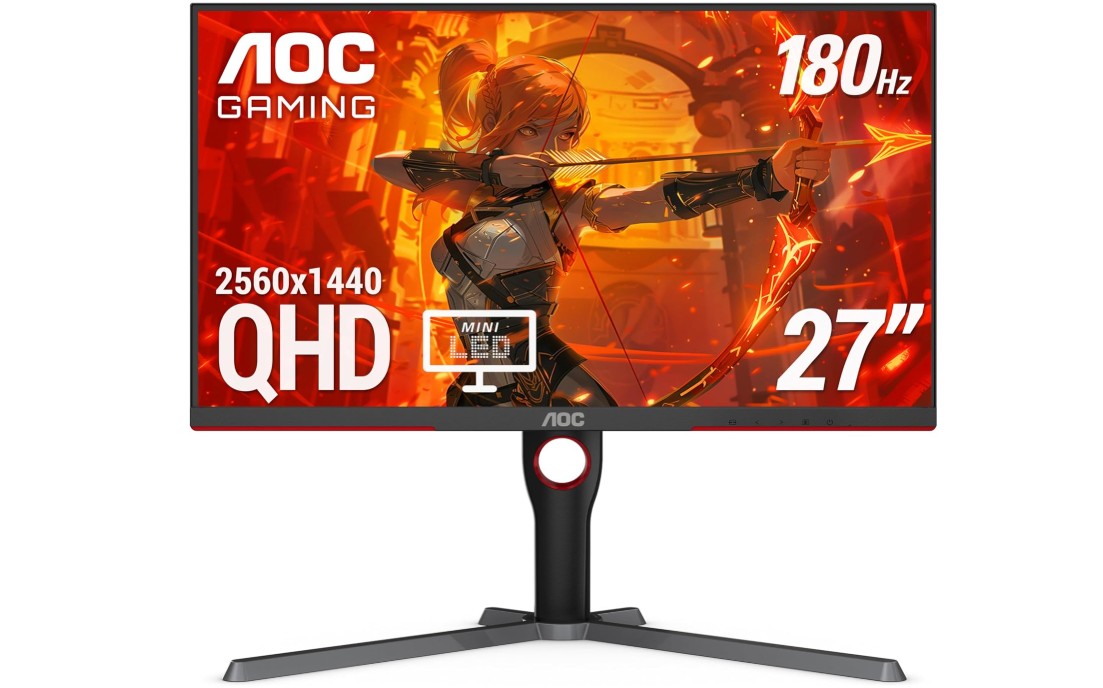
AOC Q27G3XMN 27″ 2K QHD Gaming Monitor
AOC Q27G3XMN 27″ 2K QHD Gaming Monitor
The AOC Q27G3XMN stakes its claim as one of the most affordable 27″ Mini-LED gaming monitors, packing QHD resolution, a blistering 180 Hz refresh rate, and VESA DisplayHDR 1000 certification—all at a street price under $300. In this review, we’ll explore its design, panel performance, gaming prowess, and overall value.
Design & Ergonomics
AOC outfits the Q27G3XMN in a sleek matte-black chassis with ultra-thin bezels, making it ideal for multi-monitor setups. The stand offers full tilt (-3.5° to +21.5°), swivel (±30°), height (130 mm), and pivot (90°) adjustments, catering to both landscape and portrait orientations. Build quality feels sturdy, and the 3-year “Zero-Bright-Dot” guarantee provides extra peace of mind against pixel defects.
Display Performance
At its core is a 27″ VA panel with 2560×1440 resolution and 336-zone Mini-LED full-array local dimming (FALD). Native contrast measures an impressive ~4,000 : 1, further enhanced by local dimming to approach OLED-like depth in dark scenes. Peak SDR brightness clocks in around 450 cd/m², while HDR demos spike to ~1,300 cd/m², delivering impactful highlights and deep blacks.
HDR & Color Accuracy
With a quantum-dot backlight, the Q27G3XMN covers approximately 96 % of DCI-P3 and 90 % of Adobe RGB, resulting in vivid, punchy colors that elevate HDR content. A built-in sRGB emulation mode clamps oversaturation for color-critical work. HDR performance impresses: testing with HDR YouTube demos and HDR-enabled games revealed rich tonal separation and strong luminosity, making titles like Control and Resident Evil 3 particularly striking. Note, however, that local dimming can introduce slight blooming or flicker in small bright objects against dark backgrounds—rarely a deal-breaker but worth noting for mixed-use scenarios.
Gaming Performance
Gamers will relish the 180 Hz maximum refresh rate over DisplayPort 1.4 (144 Hz via HDMI 2.0) paired with a 1 ms GtG response time, delivering fluid motion and minimal ghosting in fast-paced titles. Both AMD FreeSync Premium and NVIDIA G-Sync Compatible support ensure tear-free gameplay across fluctuating frame rates. Measured input lag remains low, and real-world testing shows the monitor keeping pace even during high-intensity firefights.
Verdict
For around $250–$280, the AOC Q27G3XMN stands out as a rare Mini-LED QHD gaming monitor under $300. Its blend of deep contrast, vibrant colors, and high refresh rate delivers an immersive experience for PC and console gamers alike. While minor local-dimming quirks and VA viewing angles persist, they’re outweighed by the display’s overall performance and value—making it a top contender in the budget HDR gaming monitor segment.
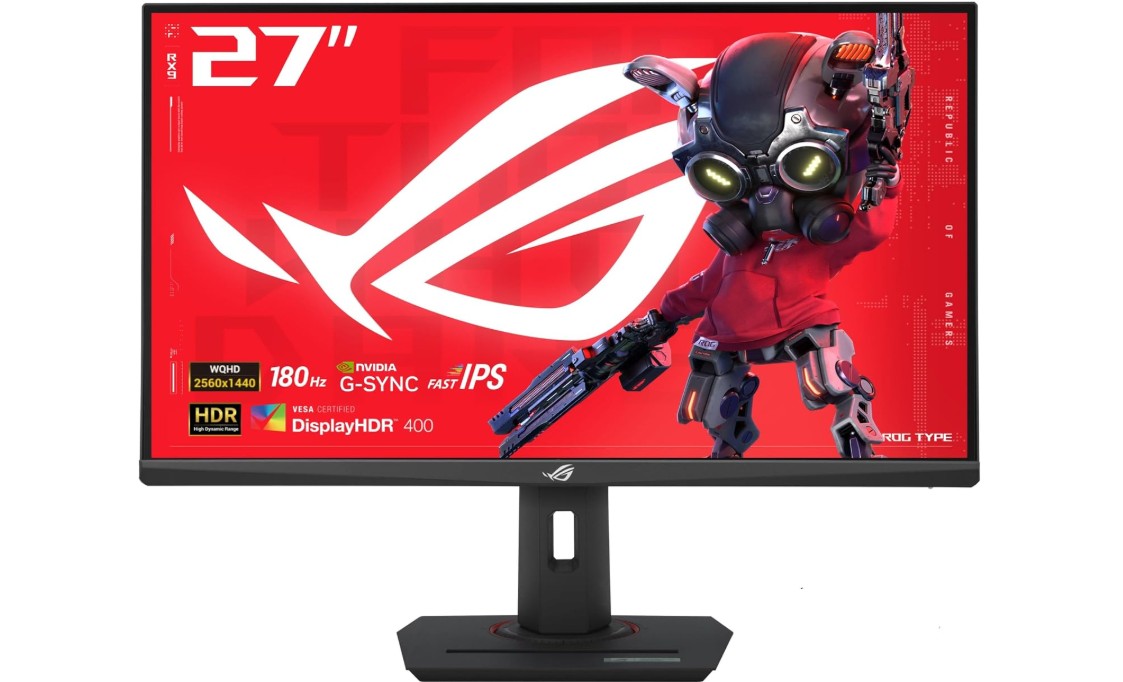
ASUS ROG Strix 27” QHD (2560×1440) HDR400 USB-C Gaming Monitor
ASUS ROG Strix 27” QHD (2560×1440) HDR400 USB-C Gaming Monitor
The ASUS ROG Strix XG27ACS positions itself as a versatile 27″ QHD gaming monitor that blends high refresh rates, accurate colors, and thoughtful extras—without demanding a premium price. With a Fast IPS panel, a 180 Hz refresh rate (via DisplayPort), and VESA DisplayHDR 400 certification, it aims to satisfy both competitive and immersive gamers. Whether you’re seeking buttery-smooth motion for esports or punchy visuals for single-player adventures, the XG27ACS makes a compelling case in the sub-$350 segment.
Design & Ergonomics
ASUS adopts a streamlined aesthetic for the XG27ACS: slim bezels, a flat-bottom stand, and a modest ROG accent on the back. The stand’s versatility is outstanding, offering tilt (–5° to +20°), swivel (±45°), height adjustment (0–120 mm), and 90° pivot for portrait mode. A unique integrated slot at the stand’s base holds a smartphone—ideal for monitoring chat or walkthroughs during gaming sessions. Build quality feels robust, and the inclusion of a tripod socket caters to content creators who need to mount cameras or ring lights.
Display & Image Quality
At 2560×1440, the Fast IPS panel delivers crisp detail and wide viewing angles (178° horizontal/vertical). Color accuracy out of the box is strong, with 133 % sRGB and 97 % DCI-P3 coverage ensuring vivid, lifelike hues. In SDR mode, the XG27ACS reaches around 350 cd/m² typical brightness; HDR scenes push that to 400 cd/m², lending highlights extra pop. Uniformity is generally solid, though some backlight bleed can appear near edges in dark scenes—common for IPS panels at this price point.
HDR Performance
VESA DisplayHDR 400 certification grants the monitor a baseline HDR experience, with respectable peak brightness and expanded color gamut. In tests, HDR game footage exhibited improved highlight detail and richer color gradients compared to SDR. However, the limited local dimming capability means blacks aren’t as deep as on higher-tier HDR monitors, and minor blooming may appear around bright objects against dark backgrounds. Still, for a budget-focused display, the HDR implementation elevates visual fidelity in supported titles.
Gaming Features & Performance
The XG27ACS shines in fast-paced scenarios thanks to its 180 Hz refresh rate (144 Hz over HDMI 2.0) and 1 ms Gray-to-Gray response time with ELMB Sync enabled. Both NVIDIA G-Sync Compatible and AMD FreeSync Premium support keep tearing at bay, and measured input lag sits below 5 ms—imperceptible to most players. Whether mowing down targets in Valorant or weaving through turns in racing sims, motion remains fluid and artifact-free, provided your GPU can sustain high frame rates.
Connectivity & Extras
Connectivity includes DisplayPort 1.4, HDMI 2.0, and a multifunction USB-C port (DP Alt Mode + 7.5 W PD) for single-cable inputs from laptops or consoles. ASUS’s DisplayWidget software adds PC-side control over GameVisual presets, shadow-boosting, and on-screen crosshairs. A 3.5 mm audio jack is onboard, but there’s no USB hub. The monitor’s slim profile and cable-management clip keep your desk tidy, and the three-year warranty underscores ASUS’s confidence in its build.
Verdict
For roughly $300, the ASUS ROG Strix XG27ACS delivers an impressive balance of speed, color fidelity, and ergonomic flair, making it a standout choice for gamers on a budget who refuse to compromise on key performance metrics. While advanced HDR enthusiasts may seek deeper local dimming or HDMI 2.1 support, the XG27ACS meets the needs of both competitive and casual players, earning its place among the best sub-$350 QHD gaming monitors.
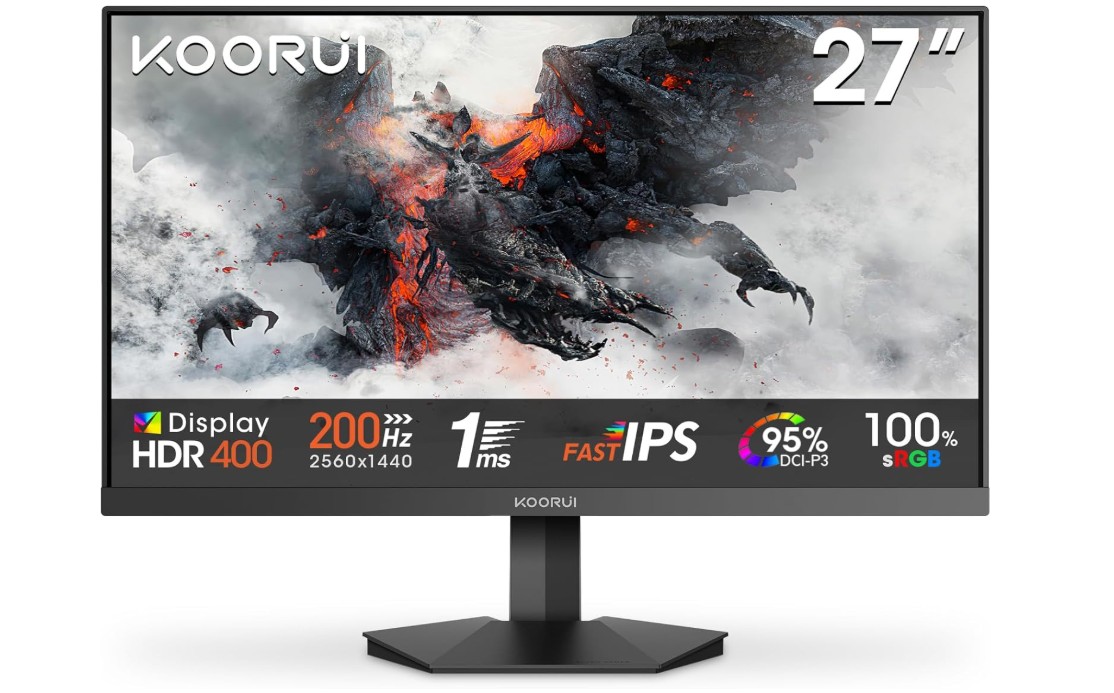
KOORUI 27″ 200Hz 1440p Gaming Monitor
KOORUI 27″ 200Hz 1440p Gaming Monitor
The KOORUI 27″ 200 Hz Gaming Monitor (model G2722P) positions itself as a high-performance yet budget-friendly option for gamers seeking 1440p clarity without compromise. With a 27″ Fast IPS panel, 200 Hz refresh rate, 1 ms response time, and VESA DisplayHDR 400 certification, it promises a balance of speed, color accuracy, and immersive visuals. In this review, we’ll break down its design, display characteristics, gaming prowess, connectivity, and overall value.
Design & Ergonomics
KOORUI outfits the G2722P in a clean, matte-black chassis with slender bezels on three sides, making it well-suited for dual- or triple-monitor setups. The stand offers tilt (–5° to +20°), height adjustment (up to 120 mm), and 90° pivot for portrait orientation. Build quality feels solid for the price bracket, though the stand’s plastic construction can wobble if bumped. Cable management is handled via an integrated clip on the stand’s column, keeping desk clutter to a minimum.
Display Quality
At its core is a 27″ Fast IPS panel rendering 2560 × 1440 pixels. Fast IPS delivers wider viewing angles (178° H/V) with consistently vibrant colors and swift pixel transitions compared to standard IPS. The panel covers 95% of the DCI-P3 gamut and is factory calibrated to ΔE ≤ 2, yielding accurate and punchy color reproduction. Contrast lands at a typical 1000 : 1, with DisplayHDR 400 support boosting peak brightness to roughly 400 cd/m² and enhancing highlight detail in HDR-enabled content. Black levels remain good for an IPS display, though you may notice some IPS glow in dark environments when viewed off-axis.
Gaming Performance
Where this monitor really shines is in fast-paced gaming. The 200 Hz maximum refresh rate (via DisplayPort 1.4) and 1 ms (DIC) response time minimize motion blur and ghosting, making rapid movements appear smooth and crisp. Both AMD FreeSync Premium and NVIDIA G-Sync Compatible technologies ensure tear-free gameplay by synchronizing the panel’s refresh cycle with your GPU’s frame output. Input lag is low enough that competitive gamers will feel confident aiming and reacting in titles like Valorant, CS:GO, and Overwatch.
Connectivity & Features
The G2722P provides two HDMI 2.0 ports and one DisplayPort 1.4 input, allowing simultaneous connections to a gaming PC and console. A 3.5 mm audio output lets you route sound to headphones or external speakers. While it lacks USB ports or an integrated USB hub, the essential video inputs cover most setups. On-screen display (OSD) controls are accessed via a joystick and buttons on the lower right bezel, offering quick adjustments for brightness, contrast, color presets, and gaming modes (Response Time, Black Stabilizer, Crosshair).
Verdict
For gamers seeking a responsive 27″ 1440p display without a premium price tag, the KOORUI G2722P delivers exceptional value. Its Fast IPS panel, 200 Hz refresh rate, and low response time combine for fluid, tear-free gameplay, while 95% DCI-P3 coverage and DisplayHDR 400 support elevate visual fidelity. Minor drawbacks like stand stability and IPS glow are forgivable at this price point. Whether you’re a competitive shooter or an immersive RPG enthusiast, the G2722P is a compelling midrange choice that punches above its weight.
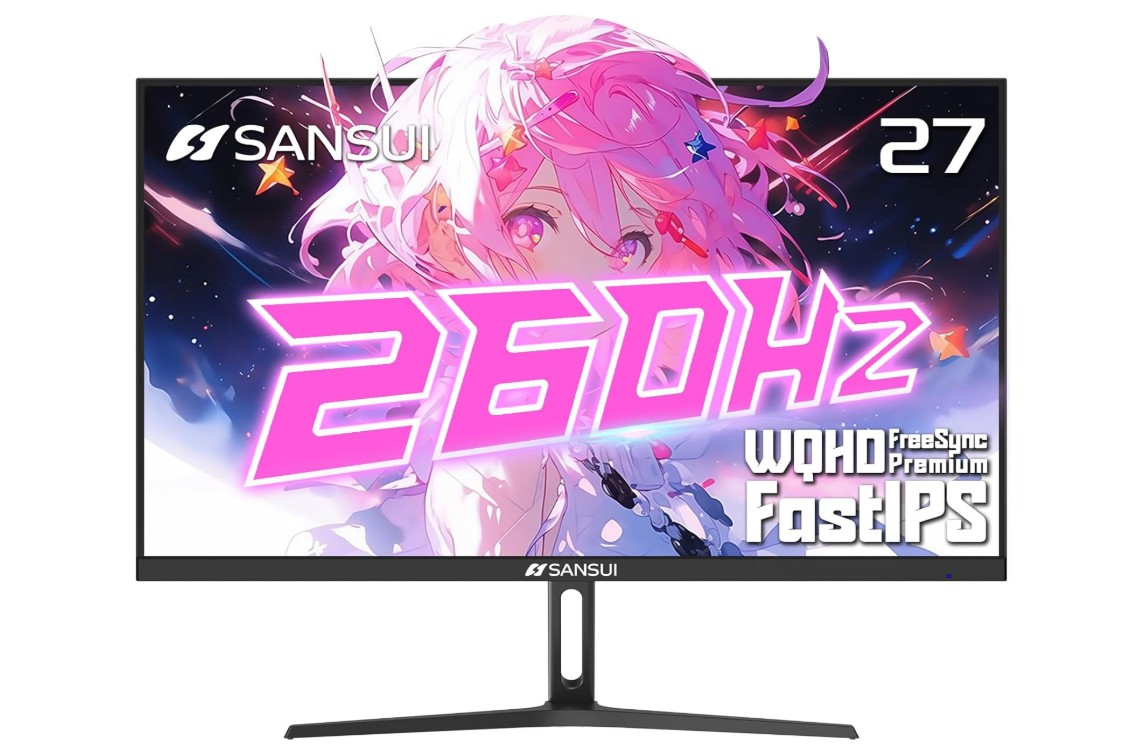
SANSUI 27 Inch WQHD 1440p Gaming Monitor
SANSUI 27 Inch WQHD 1440p Gaming Monitor
The SANSUI G27F6Q-PRO is a 27″ WQHD (2560×1440) gaming monitor that pushes the envelope for budget-friendly performance, offering up to a 240 Hz (260 Hz OC) refresh rate, 1 ms response time, and broad color coverage—all while maintaining an affordable price point. In this review, we’ll examine its design, display characteristics, gaming prowess, connectivity, and overall value.
Design & Build
The G27F6Q-PRO features a clean matte-black Fast IPS panel with slim bezels on three sides, creating a modern look that’s well-suited for both single- and multi-monitor setups. Its stand provides tilt (–5° to +20°), height adjustment (up to 130 mm), and 90° pivot for portrait mode, though the plastic construction can feel slightly less sturdy than higher-end alternatives. An integrated cable-management clip behind the column helps keep your desk tidy.
Display Quality
At its core, the Fast IPS panel delivers sharp 2560×1440 resolution with wide 178°/178° viewing angles. Color reproduction is notably vibrant, covering 98 % of DCI-P3 and 130 % of sRGB, thanks to its 10-bit HDR10 support and factory calibration for ΔE ≤ 2 accuracy. VESA DisplayHDR 400 certification elevates peak brightness to around 400 cd/m², enhancing highlights in HDR content. Contrast sits at a standard 1000 : 1, with minor IPS glow visible in dark scenes when viewed off-axis.
Gaming Performance
Where the G27F6Q-PRO really excels is in fast-paced gameplay. Its 240 Hz native refresh rate (expandable to 260 Hz via overclock) and 1 ms MPRT response time virtually eliminate motion blur and ghosting, delivering silky-smooth visuals in competitive titles. Both AMD FreeSync Premium and NVIDIA G-Sync Compatible technologies ensure tear-free performance, synchronizing the monitor’s refresh cycle with fluctuating GPU frame rates. Input lag is low enough to satisfy even the most demanding esports players.
Connectivity & Features
- Video Inputs: 2× DisplayPort 1.4 (up to 240 Hz), 2× HDMI 2.0 (up to 144 Hz)
- Audio: 3.5 mm headphone jack
- Extras: On-screen crosshair overlay, RTS/FPS game assistants, anti-flicker and low-blue-light modes
- Mounting: VESA 100 × 100 mm support Reddit
These essentials cover most modern gaming setups, though the absence of a USB hub or built-in speakers means you’ll need external peripherals.
User Impressions & Value
Across Reddit discussions, owners praise the G27F6Q-PRO for offering flagship-level specs at around $300, noting it “can’t be beat for the price” and that “everyone I asked online thinks they made the right choice for the price and extras”. While some mention minor build-quality concerns, the consensus is that its performance-to-cost ratio is exceptional.
Verdict
For gamers seeking a high-speed 27″ 1440p display without breaking the bank, the SANSUI G27F6Q-PRO delivers outstanding value. With blazing refresh rates, vivid wide-gamut colors, and tear-free adaptive-sync, it punches well above its price class. If you can look past the modest stand construction and lack of integrated extras like a USB hub or speakers, this monitor represents one of the best budget picks in the competitive 1440p gaming segment.
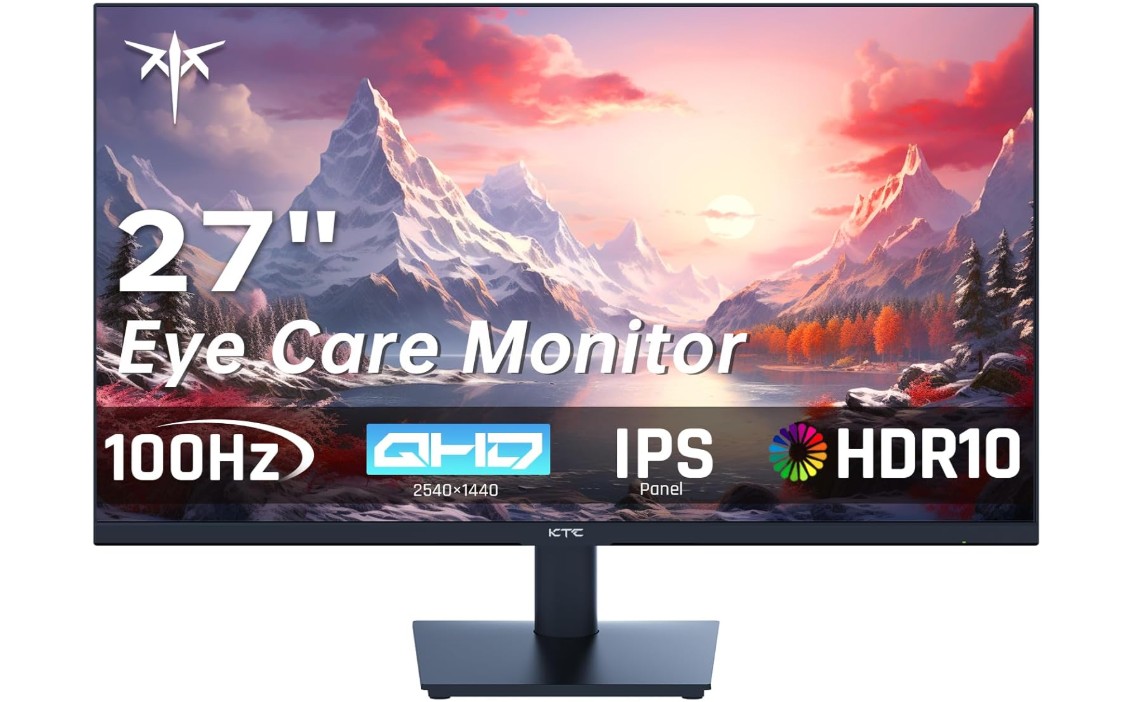
KTC 27 Inch QHD Computer Monitor
KTC 27 Inch QHD Computer Monitor
The KTC 27″ QHD Computer Monitor strikes a balance between productivity and casual gaming with its 2560×1440 IPS panel, 100 Hz refresh rate, and frameless design. Marketed as an “Eye Care” display, it promises comfortable viewing over long hours, making it equally suitable for office work, media consumption, and light gaming. In this review, we’ll explore its design, image quality, performance, connectivity, and overall value.
Design & Ergonomics
KTC outfits this monitor in an understated matte-black chassis with ultra-thin bezels on three sides, lending it a modern, minimalist look. The frameless edges help the display blend seamlessly into multi-monitor setups, reducing visual distractions. The stand offers tilt adjustment from –5° to +15°, allowing you to find a comfortable viewing angle, though it lacks height, swivel, or pivot controls. For custom mounting, the VESA-compatible 75 × 75 mm pattern ensures easy attachment to third-party arms or wall mounts.
Display Quality
At its core is an 8-bit IPS panel delivering 2560 × 1440 resolution, which provides noticeably sharper text and finer detail than Full HD. With a typical contrast ratio of 1300 : 1, blacks appear deeper than on many budget IPS displays, though not as rich as VA panels. Factory calibration achieves approximately 123 % sRGB coverage, yielding vibrant yet accurate colors ideal for photo editing, video streaming, and web design. HDR10 support increases the dynamic range for compatible content, enhancing highlights and bringing out subtle details in shadows, although the absence of local dimming limits full HDR impact.
Performance & Gaming
While not a high-end gaming monitor, the KTC 27″ offers smooth motion up to 100 Hz via DisplayPort or HDMI 2.0. This moderate refresh rate reduces motion blur and tearing compared to standard 60 Hz screens. Adaptive-Sync compatibility with both AMD FreeSync and NVIDIA G-Sync ensures tear-free gameplay when paired with a capable GPU. Response times hover around 5 ms, which is acceptable for casual gamers but may not satisfy competitive esports players. Overall, it provides a fluid experience for single-player titles and less demanding multiplayer games.
Connectivity & Features
The monitor includes two HDMI 2.0 ports and one DisplayPort 1.4 input, enabling simultaneous connection of a PC, laptop, and console. A 3.5 mm audio output allows you to route sound to external speakers or headphones. “Eye Care” features—flicker-free backlighting and low-blue-light modes—help reduce eye strain during extended use. An on-screen display menu grants quick access to brightness, contrast, color presets, and gaming modes, though navigation requires multiple button presses.
Verdict
The KTC 27″ QHD monitor is a compelling choice for users who need a versatile display for work and light gaming without breaking the bank. Its high-resolution IPS panel delivers vibrant colors and sharp detail, while the 100 Hz refresh rate and adaptive-sync support ensure smoother motion than standard office monitors. Although it lacks extensive ergonomic adjustments and advanced gaming features, its frameless design, eye-care technologies, and solid image quality make it a strong contender in the budget QHD segment. If you value crisp visuals and comfort over extreme gaming performance, the KTC 27″ strikes an excellent balance of price and capability.
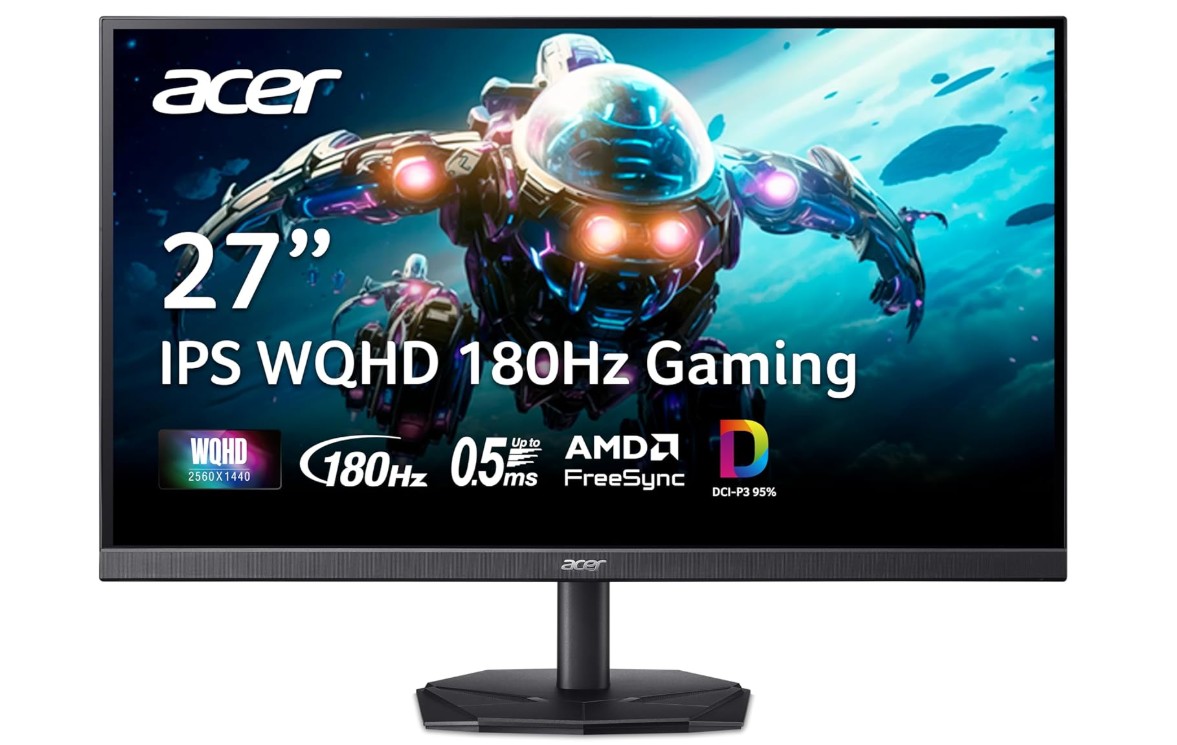
acer Nitro 27 Inch WQHD 2560 x 1440 IPS Gaming Monitor
acer Nitro 27 Inch WQHD 2560 x 1440 IPS Gaming Monitor
The Acer Nitro KG271U N3BMIIPX is a 27″ WQHD (2560 × 1440) IPS gaming monitor designed to deliver sharp visuals and fluid gameplay without commanding a premium price. Boasting up to a 180 Hz refresh rate over DisplayPort, an ultra-fast 0.5 ms overdrive response, and a wide DCI-P3 95 % color gamut, it promises crisp imagery and vibrant colors for both competitive and casual gamers. HDR10 support further enhances peak brightness and dynamic range, making it a versatile pick for mixed-use setups.
Design & Ergonomics
Acer’s Nitro KG271U sports a sleek, zero-frame design that minimizes bezel distractions and lends itself well to multi-monitor arrays. The matte-black chassis feels sturdy, and the cable-routing clip on the stand’s column helps keep your desk tidy. Tilt adjustment ranges from –5° to +25°, allowing you to find a comfortable viewing angle; however, the monitor does not offer height, swivel, or pivot adjustments out of the box. A VESA 100 × 100 mm mount ensures compatibility with third-party arms or wall mounts for more flexible positioning.
Display Quality
At 2560 × 1440 resolution, the IPS panel delivers sharp text and detailed imagery. Color coverage hits 95 % of the DCI-P3 gamut, resulting in punchy, accurate hues ideal for gaming, streaming, and creative tasks. Typical brightness is rated at 250 cd/m², with HDR10 content pushing peaks higher to enhance highlights and shadow detail. The monitor employs a dynamic contrast mechanism (up to 100 million : 1 ACM), which helps deepen blacks but cannot fully replicate local dimming. Overall uniformity is solid, with minimal backlight bleed in most units.
Gaming Performance
Where the KG271U truly stands out is in motion clarity. Via DisplayPort 1.2, it achieves up to 180 Hz refresh—equating to smoother frame delivery than typical 144 Hz displays. Overdrive tuning allows response times as low as 0.5 ms OD, significantly reducing ghosting in fast-paced scenes. AMD FreeSync support synchronizes frame rates between the GPU and monitor, eliminating screen tearing and stutter. Even when paired with NVIDIA cards, users report the FreeSync range remains compatible, delivering an appreciably tear-free experience across fluctuating frame rates.
Connectivity & Extras
The monitor offers one DisplayPort 1.2 and two HDMI 2.0 ports, enabling connections to gaming PCs, consoles, and streaming devices simultaneously. An audio line-out and headphone jack simplify routing sound to external speakers or headsets. Beneath the front bezel, intuitive OSD controls let you toggle game-centric presets—like “Action,” “Racing,” and “Sports”—plus adjust black boost, overdrive levels, and color temperature on the fly. Built-in 2 × 2 W speakers provide basic audio, but enthusiasts will likely prefer dedicated speakers or a headset for richer sound.
Verdict
For around $200–$300 depending on retailer and deals, the Acer Nitro KG271U N3BMIIPX delivers an outstanding blend of performance and affordability. Its combination of high refresh rates, ultra-fast response times, and wide color coverage caters to gamers seeking a responsive edge without sacrificing visual fidelity. While it omits some premium features like advanced ergonomics and true local-dimming HDR, its core strengths make it a compelling choice for anyone upgrading from 1080p or 144 Hz monitors. Whether you’re chasing high frame rates in esports titles or diving into richly textured single-player adventures, the KG271U stands as an excellent value in the 1440p segment.
Buying Guide For 27 Inch 1440p Gaming Monitor
Upgrading to a 27-inch 1440p (2560×1440) gaming monitor is one of the best ways to boost immersion, clarity, and overall gameplay experience without demanding the GPU horsepower of 4K. The increased pixel density over a 24-inch 1080p screen strikes a sweet spot in sharpness, offering detailed textures and wider desktop real estate, while still enabling high frame rates on midrange to high-end graphics cards. Whether you’re a competitive esports player chasing every millisecond of advantage or a single-player enthusiast seeking cinematic visuals, a 27-inch 1440p monitor can transform your rig.
This buying guide walks through the critical factors to consider when selecting a 27-inch 1440p gaming display, breaks down budget tiers, and highlights key models across entry-level, midrange, and premium categories.
Key Specifications to Evaluate
1. Panel Technology
- IPS (In-Plane Switching): Offers the best color accuracy and wide viewing angles at the cost of slightly slower response times and marginally lower contrast than VA.
- VA (Vertical Alignment): Delivers deeper blacks and higher static contrast ratios but can suffer from slower pixel transitions and ghosting in fast-paced scenes.
- TN (Twisted Nematic): Historically the fastest but now uncommon at this size/resolution due to poor color and narrow viewing angles.
2. Refresh Rate & Response Time
- Refresh Rate: Competitive gamers should aim for 144Hz or higher (up to 240Hz–260Hz), while 60–120Hz suffices for casual play.
- Response Time: Lower gray-to-gray (GtG) or moving-picture response time (MPRT) values (1–4ms) reduce motion blur and ghosting.
3. Adaptive Sync Technologies
- AMD FreeSync / FreeSync Premium / Premium Pro: Broad support at various price points; eliminates tearing and stutter when paired with compatible GPUs.
- NVIDIA G-Sync / G-Sync Compatible: Typically higher cost, with certified modules guaranteeing smooth performance on NVIDIA cards.
4. High Dynamic Range (HDR)
- HDR Standards: Look for VESA DisplayHDR 400 (entry-level), 600, or 1000 certifications. Higher tiers imply more local dimming zones and greater brightness.
- Practical Considerations: Budget 1440p HDR monitors often lack full-array local dimming (FALD), so HDR impact may be limited to increased brightness and wider color gamut.
5. Color Gamut & Accuracy
- sRGB / DCI-P3 Coverage: 100% sRGB is ideal for general usage; 95%+ DCI-P3 is preferred for richer, more saturated HDR visuals.
- Factory Calibration: Monitors with Delta E < 2 deliver more accurate out-of-box color.
6. Ergonomics & Build Quality
- Adjustments: Height, tilt, swivel, and pivot enable comfortable viewing and support multi-monitor setups.
- Bezel Design: Thin or zero-frame bezels improve immersion and ease of alignment in multi-screen arrays.
7. Connectivity & Extras
- Video Inputs: DisplayPort (1.2+ for > 144Hz), HDMI (2.0 for 144Hz at QHD, HDMI 2.1 for higher bandwidth), and USB-C on productivity-focused models.
- USB Hubs & Audio: Integrated USB ports, headphone jacks, and speakers add convenience but are optional.
- Gaming Features: On-screen crosshairs, FPS counters, and low-blue-light modes can be nice extras.
FAQs
1. Do I need a high-end GPU to run games at 1440p and high refresh rates
While 1440p is less demanding than 4K, achieving 144 Hz or above still requires a capable graphics card. Midrange GPUs (e.g., NVIDIA RTX 3060 Ti or AMD RX 6700 XT) can handle most eSports titles at high frame rates, while closed-loop ray tracing and AAA single-player adventures may need higher-end cards (e.g., RTX 4070/4070 Ti or RX 7800 XT) to sustain 100+ FPS on max settings.
2. How important is panel type when choosing a 27″ QHD monitor?
Panel type affects color, contrast, and response:
- IPS: Best choice for color accuracy and viewing angles, ideal for content creation and general gaming.
- VA: Offers deeper blacks and superior contrast, great for dark-room immersion but can exhibit slower pixel transitions and ghosting.
- TN: Rare at 1440p; fastest response but poor colors and narrow viewing angles.
3. Can I use a 27″ 1440p monitor with my console?
Yes—most modern monitors support 1440p via HDMI 2.0 up to 120 Hz. For PS5 and Xbox Series X/S, ensure your display’s HDR implementation is satisfactory and that it supports the console’s max refresh rate for a smoother experience.
4. Is HDR worth it on a 1440p monitor?
Basic HDR (DisplayHDR 400) offers brighter highlights and a wider color gamut, but without local dimming, black levels remain largely unchanged. For more impactful HDR, consider displays with FALD (mini‑LED) and DisplayHDR 600 or higher.
5. How do I reduce eye strain during extended gaming sessions?
Look for monitors with “flicker-free” backlights, low‑blue‑light modes, and adjustable brightness. Pair these with proper ambient lighting and take regular screen breaks (20 seconds every 20 minutes) to follow the 20–20–20 rule.
6. Should I prioritize resolution, refresh rate, or color gamut?
Identify your primary use case:
- Competitive Gaming: Prioritize 144 Hz+ and low response times.
- Content Creation & Single-Player: Emphasize color gamut (95%+ DCI‑P3) and HDR capability.
- Balanced Use: Opt for 144 Hz IPS panels with decent HDR and ergonomics.
7. How do I maintain and calibrate my new monitor?
Use native OSD settings or free calibration tools (e.g., DisplayCAL with a colorimeter) to fine‑tune gamma, white point, and color accuracy. Keep your monitor’s firmware updated via the manufacturer’s utility whenever available.
Making the Final Decision
- Define Your Priorities: Determine whether competitive speed, color accuracy, HDR performance, or budget is paramount.
- Check Your GPU Comfort Zone: Ensure your graphics card can reliably drive your chosen refresh rate at 1440p.
- Visit Reviews & Calibration Reports: Third-party testing reveals actual color accuracy, uniformity, input lag, and local dimming performance.
- Assess Ergonomics & Desk Space: Confirm your desk can accommodate a 27-inch screen and that adjustability meets your posture needs.
- Look for Deals & Warranty: Seasonal sales, bundle offers, and extended pixel-defect policies add value.
A 27-inch 1440p gaming monitor represents a versatile upgrade for nearly any gamer. By weighing panel type, refresh rate, adaptive sync, HDR capability, and price tier—followed by hands-on research—you’ll land on the model that elevates your gaming rig today and remains relevant tomorrow.
A passionate tech enthusiast with a deep interest in the latest innovations, gadgets, and emerging technologies. Always eager to explore cutting-edge hardware and software, I enjoy sharing insights, reviews, and recommendations to help others make informed decisions in the ever-evolving tech world. With a curious mindset and hands-on approach, I stay up-to-date with industry trends, from PCs and gaming to mobile devices and AI-driven tools.






